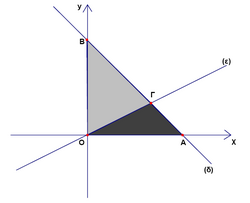Difference between revisions of "2006 Cyprus MO/Lyceum/Problem 11"
(New page: ==Problem== {{empty}} ==Solution== {{solution}} ==See also== {{CYMO box|year=2006|l=Lyceum|num-b=10|num-a=12}}) |
|||
| Line 1: | Line 1: | ||
==Problem== | ==Problem== | ||
| − | {{ | + | <div style="float:right"> |
| + | [[Image:2006 CyMO-11.PNG|250px]] | ||
| + | </div> | ||
| + | |||
| + | The lines <math>(\epsilon):x-2y=0</math> and <math>(\delta):x+y=4</math> intersect at the point <math>C</math>. If the line <math>(\delta)</math> intersects the axes <math>Ox</math> and <math>Oy</math> to the points <math>A</math> and <math>B</math> respectively, then the ratio of the area of the triangle <math>OAC</math> to the area of the triangle <math>OBC</math> equals | ||
| + | |||
| + | A. <math>\frac{1}{3}</math> | ||
| + | |||
| + | B. <math>\frac{2}{3}</math> | ||
| + | |||
| + | C. <math>\frac{3}{5}</math> | ||
| + | |||
| + | D. <math>\frac{1}{2}</math> | ||
| + | |||
| + | E. <math>\frac{4}{9}</math> | ||
==Solution== | ==Solution== | ||
Revision as of 21:55, 17 October 2007
Problem
The lines ![]() and
and ![]() intersect at the point
intersect at the point ![]() . If the line
. If the line ![]() intersects the axes
intersects the axes ![]() and
and ![]() to the points
to the points ![]() and
and ![]() respectively, then the ratio of the area of the triangle
respectively, then the ratio of the area of the triangle ![]() to the area of the triangle
to the area of the triangle ![]() equals
equals
A. ![]()
B. ![]()
C. ![]()
D. ![]()
E. ![]()
Solution
This problem needs a solution. If you have a solution for it, please help us out by adding it.
See also
| 2006 Cyprus MO, Lyceum (Problems) | ||
| Preceded by Problem 10 |
Followed by Problem 12 | |
| 1 • 2 • 3 • 4 • 5 • 6 • 7 • 8 • 9 • 10 • 11 • 12 • 13 • 14 • 15 • 16 • 17 • 18 • 19 • 20 • 21 • 22 • 23 • 24 • 25 • 26 • 27 • 28 • 29 • 30 | ||










